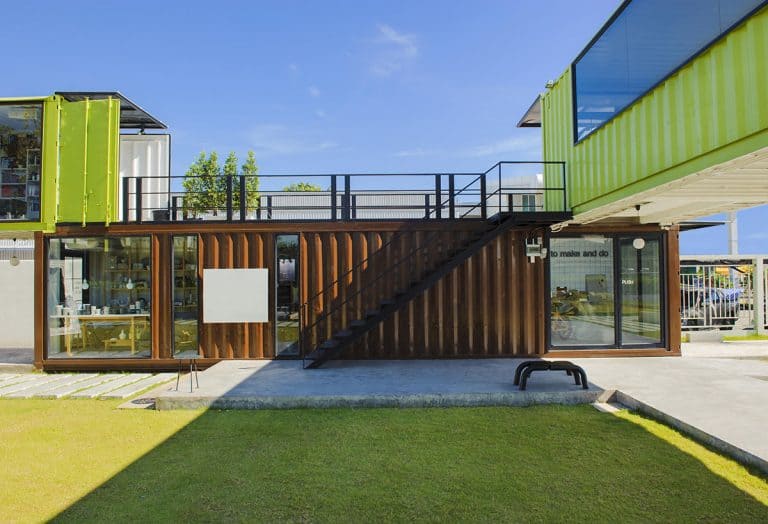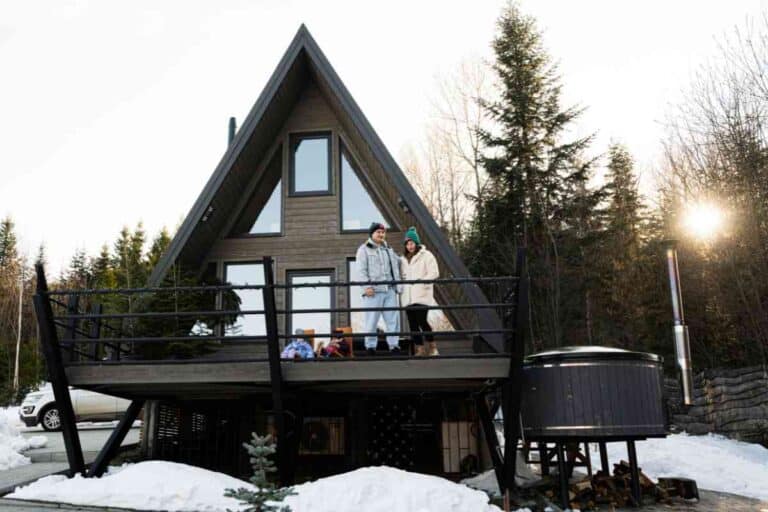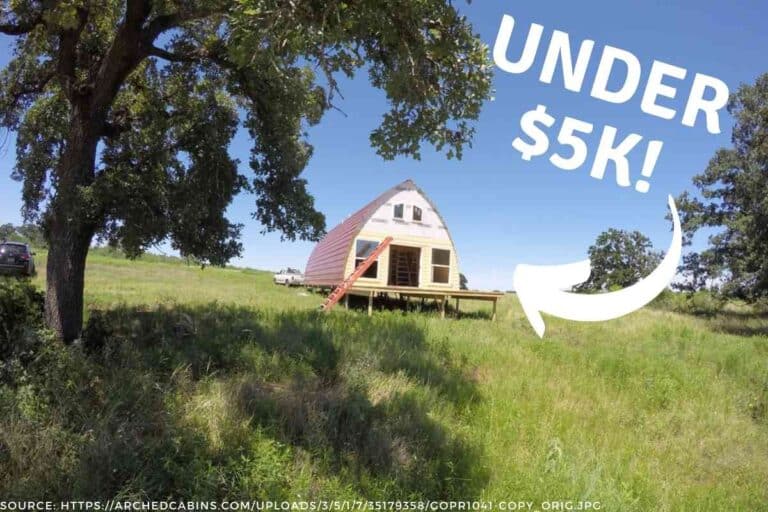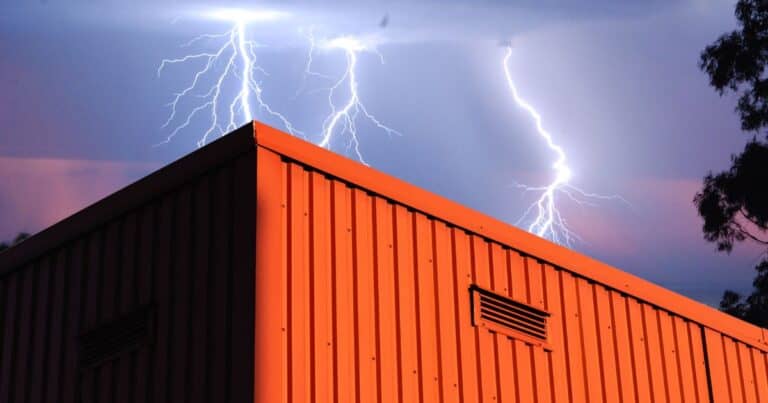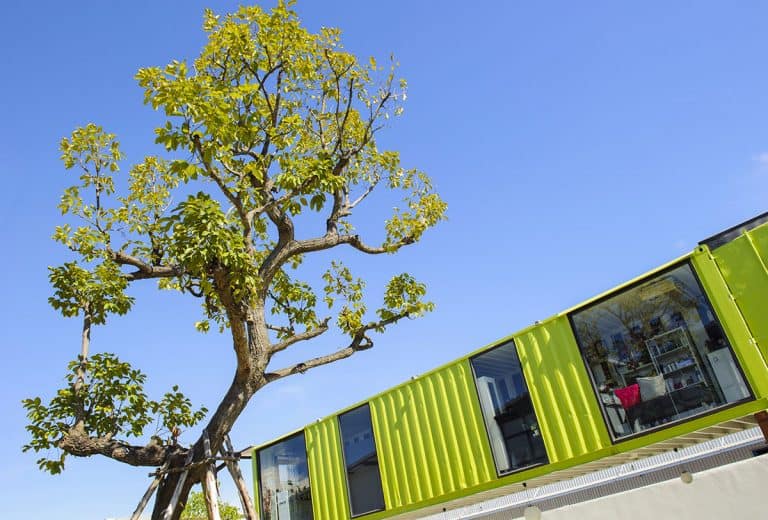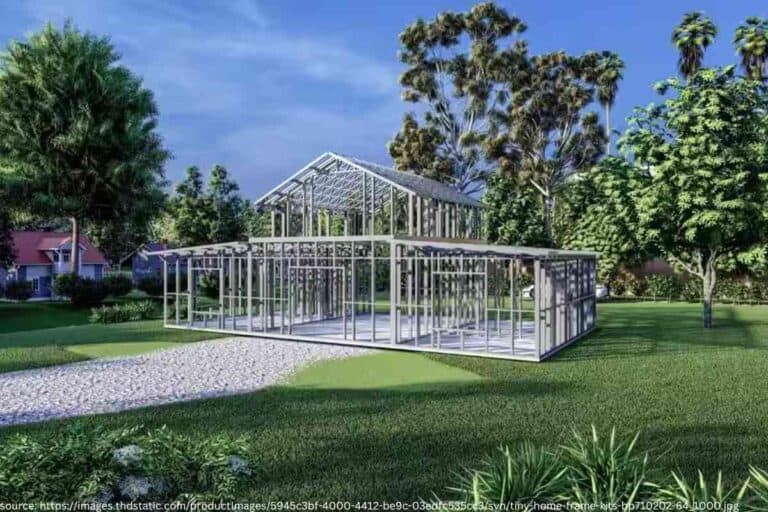Container Home vs. Tiny Home: Which Is Right For Me?
Container homes and tiny homes are sustainable alternatives to traditional housing options. The best choice for you will depend on a number of factors that will be discussed in full detail here.
The advantage of tiny houses is that they are generally much easier to customize than container homes. Container houses are built to stand the test of time as they are made out of metal meant to withstand all the elements. Both options are available in prefabricated versions.
You will have to adjust to less space if you are currently living in a traditional type of housing. Fortunately, there is a burgeoning market of furniture and fixtures that are adjustable so that they do not take up as much space when not being used. Links to some of the most popular furnishings for tiny homes are included in one of the sections below.
Is It Faster To Build A Container Home Or A Tiny Home?
If the speed at which you build your home is of utmost importance to you, then you are likely looking at the possibility of getting a prefab (prefabricated) home. Container homes also offer the potential for quick construction.
Prefab home installations are almost instantaneous: the majority of the home is built in a factory. Then, the home is brought to your property to be assembled. The length of time spent on construction will depend on how large you want the home to be.
If it’s a tiny house that you are going for, the construction process will go a lot faster if you go for a prefab home rather than an ordinary home. Prefab homes take 50% less time to construct than traditional homes, according to an article in Seattle Times.
Container homes can take longer to construct for a variety of reasons. First off, you will need to cut out space for doors and windows without their structural integrity. You will also need to make the home suitable for utilities. Making a container home comfortable in extreme hot and cold climates requires seamless insulation that prevents heated or cooled air from escaping.
Even if you were to decide on building your container home from just one single shipping container, the construction process would still likely take longer than it would a prefab home of a significantly larger size due to all the modifications that must be made to turn the container into a habitable space.
Container Homes Make It Easy To Construct With Recycled Materials
Many homeowners wish to build a home that is made out of mostly recycled materials. Container homes hold this advantage over tiny homes. It is easy to reach the lofty goal of a mostly recycled home because the shipping containers themselves will typically come at least lightly used.
Take, for example, the Smithey home. Roughly 90% of the materials in the home have been recycled. The couple owes their ability to make a recycled home to the fact that it is made of three different recycled shipping containers. It would be more difficult to do this with a tiny home, although it is still possible.
Typically it is much more difficult to construct a tiny house that is made out of mostly recycled materials. You would have to ensure that every little part is made of recycled materials. With container homes, you already know that most of the structure is going to be made out of old metal containers that will be spending the rest of its lifetime as your house.
…Although, the Term “Recycled” May Be Misleading
Many of the shipping containers used to build homes may not have been in circulation for very long, if at all. If a shipping container is going to be used to build a home, it needs to be in good enough shape to hold up as a housing structure. Shipping containers that have been around the world a few times might not hold up.
Therefore, you may have to inquire about the container’s history. It may also take an effort to find containers that have been around longer, if the recycled materials aspect is of great importance to you. In addition, there may be an extra cost associated with cleaning older containers end removing potentially toxic chemicals.
The intermodal container is still an eco-friendly housing option, largely due to its durability. There’s also the fact that less fuel will be burned delivering building materials to the site, since so much of the structure will be the containers themselves. This is much more efficient than having to transport lumber, siding, bricks, and other such building materials to the site.
Tiny Houses Will Be Easier To Heat And Cool
One knock on container homes is that the metal structure is, by its very nature, harder to heat and cool. Metal is a terrible insulator and will allow heat transfer to occur virtually uninterrupted. Outside radiant heat transfer is of particular concern with shipping containers. You are well aware of what happens to a metal surface on a sunny day.
Tiny homes, on the other hand, are exactly what they sound like. They are miniature versions of traditional homes. All the features, including air vents and insulation, will be a part of the home, regardless of whether the home was built from the ground up or is a prefab home.
Tiny homes will typically be the preferable option in hot and cold climates. These homes will not require the excessive modifications that container homes will just to make sure that the interior temperature of the home is kept at a comfortable level.
Containers Are Easy To Ship To Any Location
It’s usually easy to get intermodal containers sent to the property you are planning to build on. They are made to be transported by tractor-trailers. You may even be able to fit all the additional building materials (i.e., lumber and windows) inside the container itself. Getting together all the building materials for a tiny house may require quite a bit more effort and more visits to and from your building materials store.
This is how shipping containers are delivered to properties:
- A container is placed onto a roll-off tractor-trailer
- The truck drives to your site
- The container can be removed from the roll-off trailer in 15 minutes
Even prefab tiny homes will be more difficult to get delivered than container homes. Prefab homes will typically qualify as an oversized load on a tractor-trailer and, as such, will cost more to deliver to a location, depending on how many miles the truck needs to travel to get your home to the desired location.
Receiving a prefab home requires the consultation of logistics experts and will likely require the guidance of pilot cars to help guide the oversized load. Although, there are tiny homes that are literally on wheels. The size of these homes is limited so that they can be hitched onto a pickup truck.
Tiny Homes Allow For More Design Opportunities
One of the unfortunate aspects of container homes is the fact that you will have very little freedom to design the home according to your preferences, and you will likely have to compromise. A tiny home will allow you to play more of a role in the interior and exterior design of the home.
It’s more difficult to be creative with container homes, although some owners come up with some creative ideas. Take, for example, this beach house in New Zealand.
Some of the design features that you want may not be attainable in a container home. It takes quite a bit of work to transform a metal container into a home since you will have to do quite a bit of cutting to make room for the doors and windows that you want.
You will have a lot more design freedom with tiny houses that are built from the ground up. For inspiration, check out the many design ideas in this tiny house village in Mt. Hood. Tiny houses may be repurposed cargo trailers, small log cabins, or any other design schematic that comes to mind.
Container Homes Are Pest-Proof
Shipping containers are, by nature, more resistant to pests than other types of building materials. The metal is more difficult for vermin to burrow into and take residence in. With only a few modifications, the home can be made to be about as pest-proof as a structure possibly can be.
If you want to see just how easy it is to pest-proof a container home, just take a look at this house in Arkansas. The only product used to increase the pest resistance of the home was to add teak flooring.
You can certainly build tiny homes out of pest-resistant materials, but it will take more effort to seek out the ideal materials.
If you are living in an area where termite problems are frequent, a container home is an ideal alternative to traditional construction. Metal will certainly be preferable to wood materials in locations that are susceptible to damage from vermin.
A Tiny House Can Be of Any Size and Shape
An unfortunate aspect of container homes is the fact that the home’s size will have to conform to the dimensions of the intermodal containers that you have chosen. Tiny homes offer a significantly larger variety of floor plans and, as such, afford the owner the chance to build the home as big or as small as they would like.
Many tiny houses are smaller than any container home could possibly be. Tiny houses are often less than 150 square feet. The dimensions of the standard intermodal container are 8 x 8.5 x 20 feet or 8 x 8.5 x 40 feet. A single storage container will take up at least 160 feet of surface area, even if you get the shorter dry freight container.
The height of the shipping container will also be limited. Standard ISO containers are 8.5 feet tall while the high cube variations come in at 9.5 feet tall. This can limit your ability to build upwards, which could be your best option if you are trying to get the most out of a small piece of land.
Do Container Homes Retain their Resale Value?
One of the concerns with both tiny houses and container homes is their resale value. Both of these housing types target a niche audience. However, there is clearly one preferable option when it comes to recouping your investment.
You are likely to get a better resale value out of tiny homes. Here is why:
- Container homes require a large initial investment in order to be converted into a livable space
- Container homes cater to a niche market
- Tiny homes are often more mobile; some even have wheels
The resale value of a tiny house depends on a couple of key factors. Tiny homes retain their value best in areas where land prices are low, per CNBC. You may be able to sell your tiny house and piece of property separately if need be. This will be quite easy if you have a movable tiny house on wheels. Container homes are more difficult to move if the structure is composed of more than just one intermodal.
For the more “normal” looking, slightly larger immovable, tiny houses, there is also a growing market of potential buyers out there for those looking to downgrade to a smaller home. Possible takers include the increasing number of singles as well as empty-nesters. These are people who may not necessarily be enticed by the idea of living in a container home.
Can You Go Off The Grid With Container Homes?
Tiny homes are a popular option for remote living, where homes are constructed without being hooked up to common utilities. Solar power is typically the only way that such homes have any access to electricity. This is certainly plausible in homes that are less than 200 square feet, but can container homes be constructed off-the-grid?
The answer to that question is yes, with a few caveats. Container homes are indeed a practical option for remote (off-grid living). Container homes can be quite simplistic in design, and as mentioned earlier, it is easy to deliver a container home to a remote location.
Some locations may be too remote for a container home. The only way to get the home to the location is via a tractor-trailer. Semi-trucks may not be able to access the most remote locations, say a beautiful location in the mountains with limited road access. But in most scenarios, a container home is a viable option for off-the-grid living.
Solar panels can be added to container homes, with the caveat that the roof will need to be constructed in such a way that is conducive to successful solar capture. This will typically involve slanting the solar panels so that they are facing the south, where they will receive the most solar radiation. This can make it a little more difficult to install solar systems in container homes.
There’s also the fact that container homes typically come with higher energy demands than tiny houses. This is due to the metal framework not being a good natural insulator. In milder climates, the energy demands won’t be such an issue.
How To Make The Most Out Of Limited Space
Both container homes and tiny homes require their owners to make the most out of the limited space that is available. Interior design for tight spaces can include features like loft bedding, desks, and tables that fold up and shelving, among other such features. The best ways to maximize interior space will be discussed in further detail below.
Murphy Beds will allow you to make use of space during the day that would otherwise be occupied by a bed. If you already have the lumber and the mattress, you can save money with a DIY project using a Murphy Bed Kit.
Folding desks and tables are another essential feature of both smaller container homes and tiny homes. By the time you are done insulating a single container, you will be left with an interior that is approximately 7 feet wide. Folding kitchen tables and folding desks are much less obtrusive than standard tables that aren’t designed to conserve space.
Shelving is a must in tiny homes and container homes. This industrial pipe shelf kit is simplistic in design and also affordable, but still offers 4 tiers of storage space. The kit is affordable because you only pay for the frame, making it an excellent option for DIYers. Those looking for a full shelving unit will be interested to know that these floating wall shelves are on the less-heavy side because they are made of cedarwood.
Financing A Tiny Home Or Container Home
In order to finance a home through a personal loan or mortgage, you need to meet local building codes, have a permanent foundation, and connect to utilities. Keep this in mind when you consider committing to a tiny house or container home. You may be underestimating the end cost if you are not taking into account the type of financing you can qualify for.
Quicken Loans notes that shipping containers may not qualify as real estate. This is a problem for tiny houses as well. If there is no permanent foundation, then you will not qualify for a mortgage. Between the two, a container home is more likely than a tiny house to qualify for a mortgage. This is simply due to the foundation requirements of larger container homes.
Since many tiny homes are on wheels or are otherwise transportable by some means, financing a tiny house often entails the owner filing for an RV loan. You may also consider applying for a personal loan. These factors can make financing a tiny house difficult and expensive according to the experiences of this tiny house owner.
Under these circumstances, it may be easier to finance a container home as long as you can pass local building codes and qualify for a mortgage. The interest rates will be much lower.
Are Tiny Houses Cheaper Than Container Homes?
Tiny homes and container homes alike are going to be a cheaper alternative to traditional housing. This is a major reason that so many are drawn to these alternative housing options other than sustainability and the promise of a simpler lifestyle.
According to Yahoo Money, the average cost of buying a tiny house is about $60,000. A 20×8 foot shipping container will cost you about $2,800 in the US, according to Quicken Loans. The cost of a typical shipping container home for sale is above $100,000. Of course, this is because container homes are usually built from around 6 containers to provide much more living space than a tiny home. Besides, the property value will play a role in the sales price, making a direct comparison very difficult.
A home with a permanent foundation and utility connections will cost more. The trend with tiny homes is off-the-grid living, and these homes are often smaller than the shorter standard intermodal container. As a result, tiny houses do tend to be cheaper than container homes, although both options certainly have the potential to be cheaper than traditional housing options.
There are a number of factors that can drive up the cost of container homes that wouldn’t necessarily affect the typical tiny house. The container itself needs to be modified to be livable. These modification costs are what would drive the price of the container home up beyond that of a similarly-sized tiny house.
How Easy Is It To Get A Permit For A Tiny House?
Although dependent on your location, container homes and tiny usually require permits and must follow building codes in the same way that traditional homes do. In some areas, it may be difficult to get a permit for either of these alternative housing options.
For example, Los Angeles County states that it may be difficult to get a shipping container home to pass local building codes. A clear pathway for getting these types of homes permitted has not yet been established. As such, it can be difficult to secure any kind of financing. Resale will be a challenge.
Contrast this with the local government’s attitude towards tiny homes. In 2019 the LA City Council approved movable tiny homes as permissible permanently habitable accessory dwelling units (ADUs). In short, it may be easier to get tiny houses approved in some areas while other locales will be more difficult.
The key takeaway here is that you should do your homework before you spend your savings on a tiny home or a container home. All things being equal, the major difference between a tiny house and a container house might be how easy (or hard) they will be to get approved and financed.
Should I Get A Tiny House Or A Container Home?
The differences between a tiny house and a container house are somewhat depends a lot on your purpose and location. The best option really depends on your circumstances.
Both options may require a bit of a lifestyle adjustment on your part. Luckily, some products will help you maximize storage space, as is included in one of the sections above.
- Advantages Of Container Homes
- Easy to make out of recycled materials
- Durable
- Fit for rooftop gardens
- Affordable
- Generally more spacious
- Advantages Of Tiny Homes
- Easier To Customize
- Movable
- You have more control over price
- Easier to include windows and doors
- Utility connections are simpler to install
Both container homes and tiny houses alike are sustainable alternatives to traditional housing options. You will have the opportunity to make a home out of mostly recycled materials. These housing options are also less wasteful when it comes to land use.
Owners of tiny homes and container houses will be able to include more green space on their properties. With container homes, you will even have a chance to install and maintain a rooftop garden.
If you want a house on your property fast, then both of these options will be superior to traditional housing options. There are both container homes and tiny houses that come prefabricated. If you are not going with a prefab, it may actually be faster to install a tiny house. This is because container homes require you to make a lot of modifications in order to be habitable.

